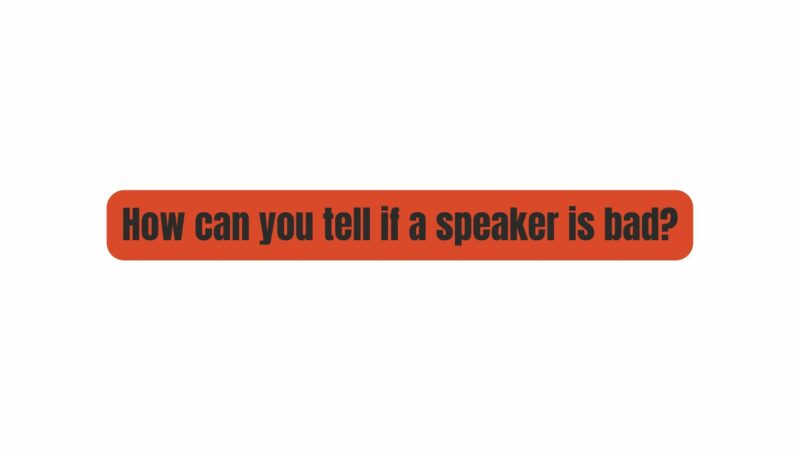Speakers are an integral part of our audio experience, whether they’re in our cars, our homes, or on our headphones. They allow us to enjoy music, movies, podcasts, and more. However, like all electronic components, speakers can degrade over time or suffer damage, leading to a decline in sound quality. In this article, we will provide a comprehensive guide to help you identify when a speaker is bad, whether you’re troubleshooting an existing audio setup or evaluating potential new speakers.
1. Auditory Clues
The most immediate and obvious indicators of a failing or “bad” speaker often manifest as changes in sound quality. Here are some auditory clues to watch out for:
A. Distorted Sound: Distortion is one of the most common signs that a speaker is bad. It can present in various forms, such as crackling, popping, buzzing, or a general degradation of audio quality. Distorted sound usually results from damage to speaker components like the diaphragm, voice coil, or surround. If you notice that your speaker is producing sounds that are no longer clear and crisp, it’s a strong indicator that something is wrong.
B. Reduced Volume: If you find yourself continually increasing the volume to reach the same audio level you once enjoyed at lower settings, it’s a clear sign that your speaker may be losing its efficiency. This can be due to weakened components, loose connections, or amplifier issues. A noticeable reduction in volume output should raise concern.
C. Weak or Missing Bass: Bass frequencies provide depth and richness to audio, and they’re crucial for an immersive listening experience. When a speaker starts to degrade, the bass response is often one of the first areas to be affected. You may notice that the bass sounds distorted, weak, or muddled, lacking the punch and clarity it once had. This can be a sign of damaged or deteriorating woofer cones, as well as problems with the speaker enclosure.
2. Visual Inspection
Sometimes, a visual inspection can provide valuable insights into the condition of a speaker. Here’s what to look for:
A. Physical Damage: Examine the speaker components for physical damage. Cracked diaphragms, torn surrounds (the flexible material that attaches the diaphragm to the speaker frame), or dislodged voice coils are all visible signs of trouble. Additionally, inspect the speaker enclosure for any damage or loose parts.
B. Dust and Debris: Dust and debris can accumulate on speaker diaphragms and affect their movement. This buildup can lead to a decrease in sound quality and responsiveness. Regularly cleaning your speakers can help prevent this issue.
3. Touch Test
The touch test involves gently pressing on the diaphragm of the speaker when it’s not playing any sound. A healthy speaker should have a consistent and even resistance when you press on it. If you notice any irregularities or unusual resistance, it may indicate a problem with the diaphragm or surround.
4. Balance Test
An imbalance in sound quality between speakers can be a strong indicator of issues with one of them. To perform a balance test, play a known good source of audio and listen carefully to each speaker individually. Are there discrepancies in sound quality between the left and right speakers or between different frequency ranges? This can help you pinpoint the problematic speaker.
5. Smell Test
Though less common, unusual smells coming from your speaker can also be a sign of trouble. Overheating or electrical issues can result in a distinct burnt or acrid odor. If you detect such smells, it’s essential to address the problem promptly, as they could signify potential safety hazards.
6. Age and Usage
Consider the age and usage of your speakers. While high-quality speakers can last for many years, they are not immortal. The lifespan of speakers varies depending on factors such as build quality, usage, and environmental conditions. If your speakers have been in service for a considerable period, it’s wise to be vigilant for signs of aging and wear.
7. Professional Evaluation
If you’re uncertain about the condition of your speakers or suspect an issue but can’t identify it, seeking professional evaluation is a prudent choice. Audio technicians or speaker specialists can perform diagnostic tests to accurately assess the condition of your speakers.
Addressing Failing Speakers
Once you’ve determined that your speaker is indeed bad and in need of attention, the next step is to address the issue. Depending on the severity of the problem, you have several options:
- Repair: In many cases, failing speakers can be repaired by replacing damaged components such as diaphragms, voice coils, or surrounds. This is a cost-effective option if the speakers are of high quality and still have life left in them.
- Replace: If the speakers are old, low-quality, or the damage is extensive, replacing them with new ones is the best course of action. Advances in speaker technology have led to better sound quality and durability in newer models.
- Upgrade: If you’re interested in enhancing your audio experience, consider upgrading to higher-quality speakers. Upgraded speakers can significantly improve sound quality and longevity.
- Consult a Professional: When in doubt, consult an audio professional. They can diagnose the issue accurately and provide recommendations for repair, replacement, or upgrading.
In Conclusion
Identifying when a speaker is bad is crucial to ensure that you continue to enjoy high-quality audio. From distorted sound and reduced volume to unusual smells and visual damage, these signs can help you determine when it’s time to take action. Whether you choose to repair, replace, or upgrade your speakers, addressing speaker issues promptly will ultimately lead to a more satisfying and immersive audio experience. Remember that good speakers are worth investing in, as they are key to enjoying the best possible audio quality.


